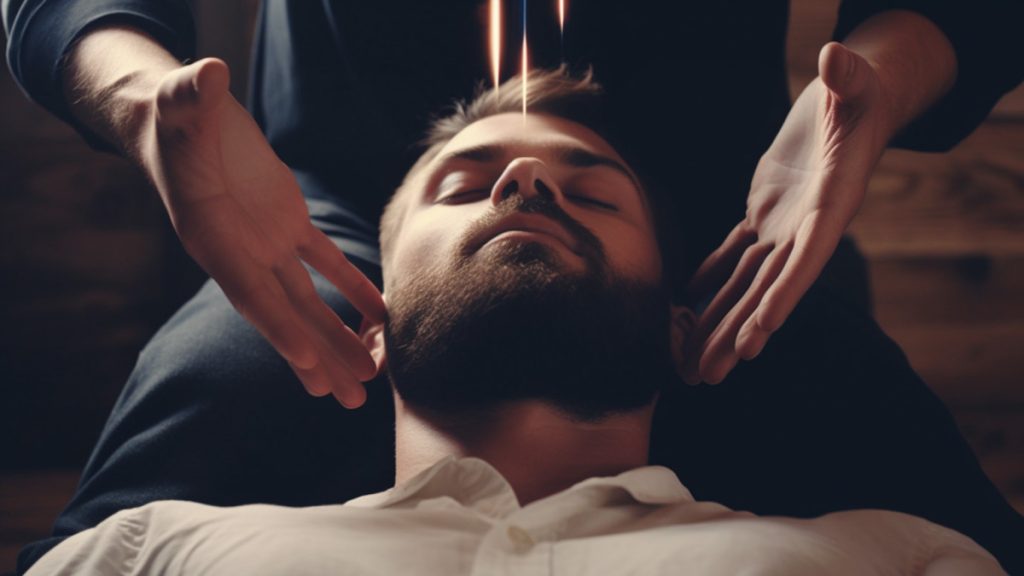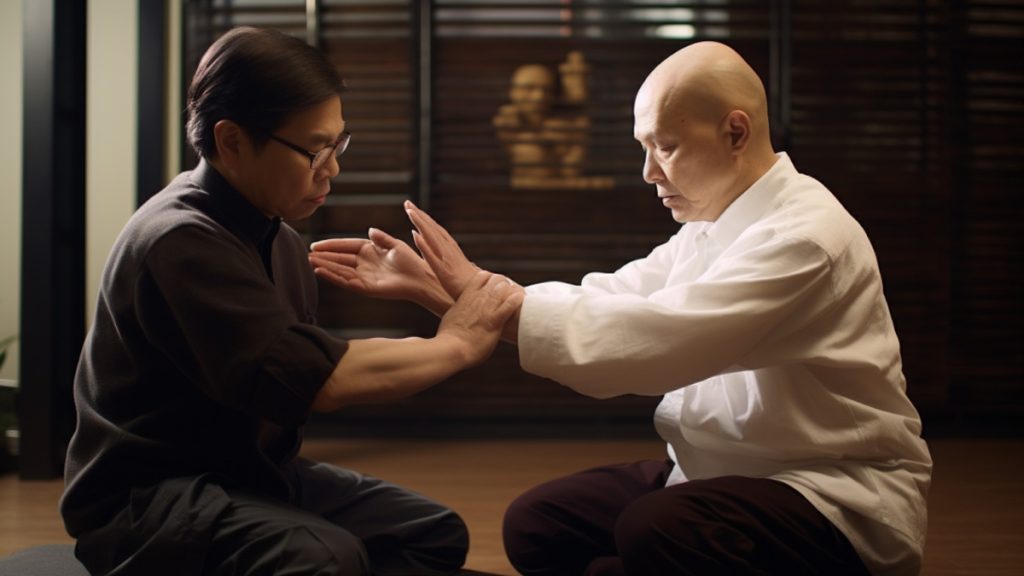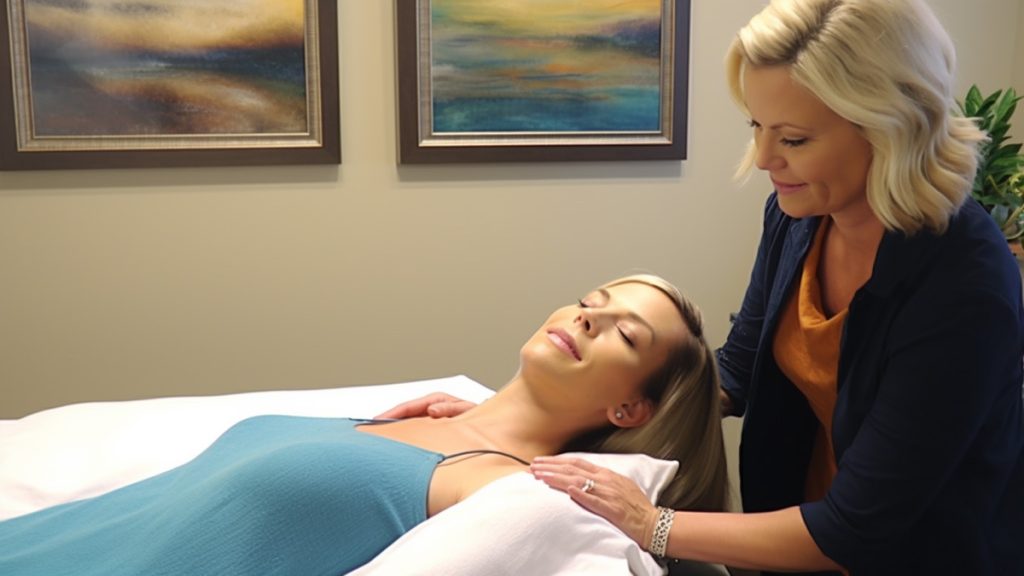Last Updated on January 16, 2025 by Avia
If you’re anything like me – you might see a lot of holes in conventional medical practices and procedures. I just can’t stand how healthcare has become commercialized. Not to mention – mass pharma and medical institutions are more about making a buck these days than they are about healing the individual from the inside out. If you can relate, you might be looking for alternative healing, as I have been doing for quite some time now. Enter the realm of biofield therapy. In my own life, I’ve found different types of biofield therapy to be extremely helpful in managing my 30-year-old back injury, crushing my stress levels, and it’s even helped me with migraines. But what is biofield therapy? Can it be useful in our healing? I’m hoping to satisfactorily answer these and a bunch more questions about this intriguing aspect of alternative therapy.
Table of Contents
- What is Biofield Therapy?
- The Origins and History of Biofield Therapy
- How Do Biofield Therapies Work?
- What Are the Different Types of Biofield Therapy and How Each One Can Help You?
- Effects of Biofield Therapy on the Brain
- Benefits of Biofield Therapy
- What Conditions Does Biofield Therapy Help With?
- Who Should Consider Biofield Therapy?
- Are There Any Risks to Doing Biofield Therapy?
- Tips on Practicing Biofield Therapy
- Frequently Asked Questions About Biofield Therapy
- The Last Word on “What is Biofield Therapy?”
What is Biofield Therapy?
Biofield therapy is a holistic approach to healing that focuses on the energy fields surrounding and within the human body. It recognizes that we are both physical and energetic beings and aims to restore balance and harmony in our bioenergy field.
The biofield refers to the subtle energy or life force that exists within and around us. It includes electromagnetic fields, vibrations, frequencies, and other energy patterns. Biofield therapy practitioners believe that when this energy becomes imbalanced or blocked, it can result in physical, mental, emotional, or spiritual disease.
The Origins and History of Biofield Therapy
The origins and history of biofield therapy can be traced back to ancient healing practices that recognized the existence of a subtle energy field surrounding the human body. In various cultures, this energy has been referred to as qi, prana, or life force.
One of the earliest recorded forms of biofield therapy is found in traditional Chinese medicine, where practitioners use techniques such as acupuncture and qigong to balance and manipulate the flow of energy within the body. Similarly, Ayurvedic medicine from India also emphasizes the importance of balancing and enhancing this vital life force.
In more recent times, pioneers like Franz Anton Mesmer explored what he called “animal magnetism” in Europe during the 18th century. His work laid some foundations for later developments in biofield therapies.
It was not until the mid-20th century that scientific research began to explore these concepts further. Physicist Harold Burr coined the term “biofield” itself in his book “Blueprint for Immortality,” published in 1947. This sparked interest among scientists who sought to understand how this subtle energy field could affect health and well-being.
As our understanding continues to evolve through ongoing research and exploration into these ancient practices, new insights are being gained about their potential benefits on physical, cognitive, and emotional levels.
Nevertheless, the historical roots serve as a reminder that humans have long recognized and utilized our inherent connection between mind, body, and spirit

How Do Biofield Therapies Work?
Biofield therapies work by harnessing the power of the human energy field, also known as the biofield. This invisible field surrounds and permeates our bodies, containing vital life force energy. When this energy becomes blocked or imbalanced, it can lead to physical, mental, and emotional ailments.
Biofield therapists aim to restore balance and harmony within the biofield through techniques such as Reiki, Healing Touch, and Qi Gong (I’ll get into each of these different types of biofield therapy in a minute). They do this by channeling universal life force energy through their hands or intentions.
During a session, a therapist may use gentle touch or hold their hands slightly above your body. The goal is to help remove any blockages or stagnant energy that may be causing discomfort or disease. By doing so, they facilitate the body’s natural healing process.
These therapies are believed to stimulate relaxation responses in the body and promote self-healing at all levels – physical, emotional, mental, and spiritual. It is thought that balancing the biofield helps restore optimal health by enhancing vitality and overall well-being.
While scientific evidence for these therapies is still emerging, many individuals report profound experiences of deep relaxation. More individual reports also cite lower stress levels and improved physical health after receiving biofield therapy sessions.
It’s important to note that each person may have a unique biofield therapy experience based on their needs and beliefs. Some people may feel an immediate release of tension during a session, while others might notice gradual changes over time.
Because everybody is different, the effectiveness of these therapies differs from person to person depending on factors such as their openness to receiving energy work and their willingness to actively participate in their own healing journey.
Biofield therapies offer a holistic approach towards wellness by addressing physical symptoms and considering energetic imbalances in the body-mind-spirit connection.
What Are the Different Types of Biofield Therapy and How Each One Can Help You?
There are several different types of biofield therapy, each with its own unique approach and benefits. Here are a few examples:
Reiki
This Japanese technique involves the practitioner placing their hands lightly on or just above their body to channel energy and promote healing. It can help help relieve pain (including chronic pain), lower stress, and much more.
Healing Touch
This therapy uses gentle touch or near-body movements to clear blockages in the energy field surrounding your body. It aims to balance your energy centers and promote relaxation, reduce anxiety, and boost immune function.
Therapeutic Touch
Similar to a healing touch, a therapeutic touch involves the practitioner using their hands to assess and rebalance their energy field. It can help alleviate pain, improve wound healing, decrease anxiety levels, and support overall wellness.

Qigong
Originating from Chinese medicine practices, qigong combines movement with deep breathing exercises to cultivate vital life force energy (known as qi). It can enhance mental clarity, increase vitality levels, promote emotional balance, and strengthen the immune system.
Pranic Healing
This modality focuses on cleansing and energizing the body’s biofield by utilizing specific hand movements over certain areas of the body without physical contact. Pranic healing is believed to accelerate natural healing processes while also improving overall health.
Each type of biofield therapy harnesses our inherent ability for self-healing by working with our energetic systems in different ways.
Effects of Biofield Therapy on the Brain
Biofield therapy has been found to have numerous positive effects on the brain. One of the main ways it impacts the brain is by reducing stress and promoting relaxation. When we get stressed or freaked out, our bodies release high amounts of cortisol, a hormone that can be harmful. Biofield therapy helps lower cortisol levels, making us feel calmer and more at ease.
In addition to reducing stress, biofield therapy also positively triggers the production of endorphins in the brain. Endorphins are known as “feel-good” chemicals because they promote feelings of happiness and well-being. By increasing endorphin levels, biofield therapy can help improve mood and overall mental health.
Research has shown that biofield therapy can also enhance cognitive function. It has been found to improve focus and concentration, making it beneficial for those struggling with attention-deficit disorders or difficulty staying focused.
Furthermore, biofield therapy has been found to increase alpha brain wave activity. Alpha waves deal with the relaxation of the mind and improved creativity. By increasing alpha waves in the brain, biofield therapy may enhance problem-solving abilities and encourage innovative thinking.
The effects of biofield therapy on the brain are remarkable. This alternative healing modality offers a holistic approach to mental well-being without relying on medication or invasive procedures, from reducing stress and promoting relaxation to improving cognitive function and enhancing creativity.

Benefits of Biofield Therapy
Biofield therapy offers a wide range of benefits for both physical and mental well-being. Here are some key advantages individuals can experience through this holistic approach.
Stress Stomper
Biofield therapy is known to promote deep relaxation and stress reduction. Working with the body’s energy field helps release tension and restore balance within the mind and body. This can prompt better sleep, lower anxiety, and calm vibes.
Stimulates Self-Healing
Biofield therapy has been found to enhance the body’s natural healing abilities. It prompts the flow of energy throughout the body, which in turn promotes self-healing processes. This can be particularly helpful for folks who grapple with chronic pain or recovering from injuries or illnesses.
Immune Boosting
Furthermore, biofield therapy has shown promising results in boosting immune function. Balancing the body’s energy system, it supports a strong immune response against pathogens and diseases.
Cuts Through Mental Fog
In addition, many people who have received biofield therapy report increased mental clarity and improved focus. The treatment helps to clear energetic blockages that may hinder cognitive function and emotional well-being. As such, these alternative therapies are also known to boost creativity and enhance mental flexibility.
Plays Nice With Conventional Medicine
Moreover, biofield therapy is often used as a complementary approach to conventional medical treatments. It can help alleviate side effects from medications or procedures while supporting overall healing and recovery.
It Isn’t Rude (Non-Invasive)
One significant benefit of biofield therapy is its non-invasive nature. Unlike invasive medical interventions or pharmaceuticals with potential side effects, this gentle practice carries minimal risk while providing numerous benefits for holistic health.
What Conditions Does Biofield Therapy Help With?
Biofield therapy, with its focus on balancing the body’s energy field, has shown potential to assist with a wide range of health conditions. While more research is needed to fully understand its effectiveness, many individuals have reported positive results from this alternative therapy.
Ouch! Chronic Pain
I’m all too familiar with this one. As mentioned in my intro, biofield therapies have helped me manage chronic pain from a back injury I sustained over 30 years ago. It works to restore balance and flow within the body’s energy field. In this way, it can potentially alleviate discomfort and reduce reliance on pain medications.
Shoo Away Stress
Another area where biofield therapy shows promise is stress reduction. The soothing effects of this practice can help promote relaxation and ease anxiety levels. Many people find regular sessions can improve mental well-being and a greater sense of peace.
Get Better Zzzz’s
Additionally, biofield therapy may be beneficial for those struggling with sleep disorders such as insomnia. Rebalancing the body’s energy field can create an environment conducive to restful sleep and enhanced overall sleep quality.
Tames Tummy Turmoil
Furthermore, some individuals have reported improvements in digestive issues through biofield therapy. This could be due to the ability of this technique to promote relaxation within the body and support proper digestion.

Who Should Consider Biofield Therapy?
Biofield therapy is a gentle and non-invasive approach to healing that can benefit people from all walks of life. Biofield therapy may be worth considering whether you are dealing with physical, emotional, or mental health issues.
If you have chronic pain, stress, or fatigue, biofield therapy can help restore balance and promote relaxation in your body and mind. It can also be beneficial for individuals seeking relief from anxiety or depression.
Biofield therapy offers a holistic approach to wellness for those who have tried traditional medical treatments without success or are looking for alternative options to complement their existing therapies. It focuses on the whole person rather than just the symptoms.
Biofield therapy is safe for all age groups, including children and older adults. It might also be helpful to people who prefer natural approaches to healing or those who wish to enhance their overall well-being.
Whether you have a specific health concern or simply want to improve your quality of life, consider exploring biofield therapy as a complementary treatment option. Consult a qualified practitioner specializing in this field to determine if it is right for you.
Remember that each person’s experience with biofield therapy may vary. What works well for one individual may not work as effectively for another. Therefore, it is important to approach this modality with an open mind and realistic expectations.
Consider trying biofield therapy if you are curious about its potential benefits and willing to commit some time and effort to exploring this natural healing method. You never know how it could positively impact your well-being until you give it a chance!
Are There Any Risks to Doing Biofield Therapy?
I haven’t had any adverse effects – but everybody is different. Risks to consider when undergoing biofield therapy are relatively minimal, but it’s important to be aware of them. Since this form of therapy involves manipulating and balancing energy fields, some clients may experience a temporary discomfort or emotional release during or after a session. This can manifest as physical sensations such as tingling, warmth, or even temporary fatigue.
In rare cases, some people with certain medical conditions may not respond well to biofield therapy. For example, those with pacemakers or other electronic implants should exercise caution due to the potential interference from electromagnetic fields generated during the therapy.
It’s also essential to ensure that you’re receiving biofield therapy from a qualified and experienced practitioner who adheres to ethical guidelines. Like any therapeutic modality, there is always a risk if an untrained individual attempts to administer biofield therapies without proper knowledge and understanding.
While these risks are generally low in comparison to traditional medical interventions, it’s still crucial for individuals considering biofield therapy to consult with their healthcare provider beforehand. They can evaluate your specific health circumstances and advise on whether this form of treatment is suitable for you.
Remember that every person responds differently to different types of therapies. What works well for one person may not have the same effect on another. It ultimately comes down to personal preference and what resonates best with your unique needs and goals.

Tips on Practicing Biofield Therapy
By now, I’ve (hopefully) adequately answered the question, “What is biofield therapy?” and offered insight into how it could work wonders in your life. Now seems like a good time to talk about how to practice biofield therapy for yourself, or what to expect if you work with a biofield therapist.
Get Quiet and Comfy
Creating the right environment is key to practicing biofield therapy effectively. Choose a calm and peaceful spot where you won’t be easily distracted.
Relax Body
I love that line coined by Jeff Bridges’ character in the movie R.I.P.D…”Relax body!” because it’s a great mantra for practicing biofield therapies. Before starting, take a few moments to relax your mind and body through deep breathing exercises or meditation. This will help you enter a state of relaxation and receptivity.
Focus Pocus!
Set clear intentions for your biofield therapy practice. Whether it’s promoting healing, reducing stress, or enhancing well-being, having a specific focus can amplify the effects of the therapy.
See the Healing
Visualization is an important component of biofield therapy. Imagine energy flowing throughout your body, balancing any areas that feel blocked or imbalanced.
Be Gentle
Depending on the type of biofield therapy you’re practicing, you may use gentle touch or non-contact methods like hand movements or visualization techniques to work with the energy field around the body.
Let Intuition Be Your Guide
As you engage in biofield therapy, trust your intuition and let it guide you in working with energy patterns within yourself or others.
Seek a Professional Biofield Therapist
If you’re new to biofield therapy or want more advanced techniques, consider seeking guidance from an experienced practitioner who can provide personalized instruction and support.
Remember that everyone’s experience with biofield therapy may vary, so be open-minded and patient as you explore this practice for yourself!
Frequently Asked Questions About Biofield Therapy
It’s a question that many people have when they first hear about this alternative healing practice. Biofield therapy, also known as energy healing, focuses on the idea that our bodies have an energy field or “biofield” that can be manipulated to promote health and well-being.
Practitioners use various techniques to balance and restore the body’s energy flow. These techniques can include hands-on touch, distant healing, or even using crystals or other tools to direct energy. The goal is to remove blockages in the biofield and encourage the body’s natural ability to heal itself.
While there is still ongoing research in this area, many studies have shown promising results. Some research suggests that biofield therapies may help reduce stress levels, alleviate pain symptoms, and improve overall well-being. However, it’s important to note that more research is needed for conclusive evidence.
Yes! Biofield therapy can be beneficial for people of all ages and conditions. Whether you’re seeking relief from physical ailments like chronic pain or emotional issues such as anxiety or depression, biofield therapy offers a holistic approach to wellness.
Generally speaking, biofield therapies are considered safe when practiced by trained professionals. However, discussing any concerns with your doctor or health professional prior to beginning any new treatment regimen is always important.
How many you need depends on your individual needs and goals. Some people find benefit from just one session while others may choose regular sessions for ongoing support. This can be discussed with your therapist based on your specific situation.
Absolutely. Talk to your doctor first, but because biofield therapies are so non-invasive, and work holistically to heal the body – many people report this alternative therapy is a compliment (not a hindrance) to their regular medical treatments.

The Last Word on “What is Biofield Therapy?”
Biofield therapy is a fascinating and promising field that has gained recognition for its potential to improve overall well-being. With its origins rooted in ancient healing practices, biofield therapy harnesses the power of subtle energy fields to promote balance and harmony within the body.
Through various techniques such as Reiki, therapeutic touch, and Qi Gong, biofield therapies work by clearing blockages in the energy field, allowing vital life force energy to flow freely. This can have super-powerful effects on both physical and emotional health.
The benefits of biofield therapy are numerous. It can crush stress levels and anxiety, alleviate pain and inflammation, enhance relaxation and sleep quality, boost immune function, promote mental clarity and focus, and support overall vitality.
Biofield therapy has shown promise in treating a buffet of conditions, including chronic pain conditions like fibromyalgia or arthritis, neurological disorders like multiple sclerosis or Parkinson’s disease, mental health issues such as depression or anxiety disorders, autoimmune diseases like rheumatoid arthritis or Crohn’s disease. Just remember – more research is required to fully understand the inner workings of these therapeutic effects.
Anyone looking for alternative approaches to healing should consider exploring biofield therapy as part of their wellness journey. Whether seeking relief from physical ailments or simply wanting to create a greater sense of balance in your life, biofield therapy offers an all-encompassing approach that addresses mind, body, and spirit.
All that said, I hope you’ve found this information on “what is biofield therapy” insightful and helpful. And as always, thanks for reading! Happy healing!
Mighty brightly,

© Copyrighted. All Rights Reserved.
Want more? Me too! That’s why I’ve also got this for you on Whats-Your-Sign:








